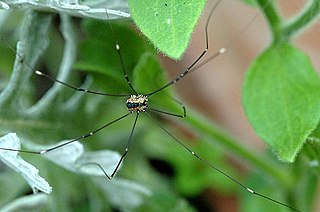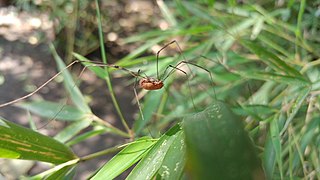Related Research Articles

Hogna is a genus of wolf spiders with more than 200 described species. It is found on all continents except Antarctica.

Pachylinae is the most diverse subfamily of the harvestman family Gonyleptidae, including around 400 valid species. Major groups of species occur in the Brazilian Atlantic forest, Bolivian/Peruvian highlands, Argentina and Chilean temperate forest.

Tmarus is a genus of crab spiders, comprising 227 species:

The Sclerosomatidae are a family of harvestmen with about 1,300 known species. One former subfamily has been recently removed to form a new family, Globipedidae.

Leiobunum is a genus of the harvestman family Sclerosomatidae with more than 100 described species. Contrary to popular belief, they are not spiders, although they share a resemblance. They are arachnids, in the order Opiliones, harvestmen. Species in Leiobunum tend to have relatively long legs compared with other harvestmen, and some species are gregarious.
The Stygnopsidae are a small family of harvestmen, with almost all species found in Mexico.
The Stygnidae are a family of neotropical harvestmen within the suborder Laniatores.
Agoristenidae are a neotropical harvestman family of the Suborder Laniatores, in the superfamily Gonyleptoidea.
Kimulidae is a small neotropical family of the harvestman infraorder Grassatores with about thirty described species.

Samoidae is a family of the harvestman infraorder Grassatores with about fifty described species.
Paratamboicus was a genus of harvestmen in the family Sclerosomatidae from the Americas, described by Mello-Leitão 1940 with the type-species by original designation being Paratamboicus bicornutus Mello-Leitão, 1940. It was much later considered as Junior subjective synonym of Holcobunus Roewer 1910 by Tourinho & Kury (2001).

Prionostemma is a large genus of harvestmen in the family Sclerosomatidae from Mexico, Central America, and South America.
Caelopyginae is a harvestmen sub-family in the family Gonyleptidae, containing the following genera:

Mangora is a genus of orb-weaver spiders first described by O. Pickard-Cambridge in 1889.
Taito is a genus of harvestmen in the family Cosmetidae. The genus is endemic to the Amazon Basin in Brazil, Colombia, Ecuador and Peru.
References
- Joel Hallan's Biology Catalog: Manaosbiidae
- Pinto-da-Rocha, R., Machado, G. & Giribet, G. (eds.) (2007): Harvestmen – The Biology of Opiliones. Harvard University Press ISBN 0-674-02343-9